-
Seed Shop
-
Feminized
Cannabis seeds -
Autoflowering
Cannabis Seeds -
Regular
Cannabis Seeds -
F1 Hybrid
Cannabis Seeds -
CBD
Cannabis Seeds -
Zamnesia
Cannabis Seeds
-
Top 10’s
- Top 10 Feminized Seeds
- Top 10 Autoflowering Seeds
- Top 10 Regular Seeds
- Top 10 USA Cannabis Strains
- Top 10 Zamnesia Seeds
-
Favourites
- Beginner Strains
- Below 1% THC
- Classic Cannabis Strains
- Cup Winners
- F1 Hybrids
- Fast-Flowering Strains
- High CBD Strains
- High THC Strains
- Mix Packs
- Zamnesia Exclusive Collabs
-
-
Headshop
-
Vaporshop
- Spare Parts & Accessories
- AirVape X
- AirVape XS GO (2021)
- Arizer Air MAX
- Arizer Extreme Q
- Arizer Solo 2
- Arizer V-Tower
- Arizer XQ2
- Boundless CFC 2.0 Vaporizer
- Boundless CFX
- Boundless TERA (V3)
- CRAFTY+
- DaVinci IQ2
- DaVinci IQC
- DaVinci MIQRO
- Dr. Dabber Boost EVO
- Dr. Dabber Stella
- DynaVap Omni 2021
- DynaVap VapCap "M" PLUS 2023
- DynaVap VapCap 'M' 2021
- DynaVap VonG (i) Titanium
- Dynavap The "B" Series
- Eagle Bill
- Firefly 2+
- Flowermate Aura
-
Healthshop
-
Smartshop
-
Shroomshop
-
Growshop
-
Seed Shop
All CategoriesSeed Shop
-
Vaporshop
All CategoriesVaporshop
- Top 10 Vaporizers
- Spare Parts & Accessories
- AirVape X
- AirVape XS GO (2021)
- Arizer Air MAX
- Arizer Extreme Q
- Arizer Solo 2
- Arizer V-Tower
- Arizer XQ2
- Boundless CFC 2.0 Vaporizer
- Boundless CFX
- Boundless TERA (V3)
- CRAFTY+
- DaVinci IQ2
- DaVinci IQC
- DaVinci MIQRO
- Dr. Dabber Boost EVO
- Dr. Dabber Stella
- DynaVap Omni 2021
- DynaVap VapCap "M" PLUS 2023
- DynaVap VapCap 'M' 2021
- DynaVap VonG (i) Titanium
- Dynavap The "B" Series
- Eagle Bill
- Firefly 2+
- Flowermate Aura
- Flowermate Cap Pro
- Flowermate Slick
- Flowermate V5.0S Pro
- G Pen Connect
- G Pen Elite II
- G Pen Micro+
- G Pen Pro
- G Pen Roam
- Hydrology9 Vaporizer
- Hyer Big-E Rig
- MIGHTY
- MIGHTY+
- PAX Mini
- PAX Plus
- PLENTY
- Pax 3 Vaporizer
- Puffco Peak PRO Smart Rig
- Puffco Peak Smart Rig
- Puffco Plus
- Storm Vaporizer
- The Proxy (Puffco)
- VOLCANO CLASSIC
- VOLCANO HYBRID
- Vape-Lifter
-
Smartshop
All CategoriesSmartshop
- Top 10 Smartshop
- Zamnesia Gift Cards
- After Party
- Aphrodisiacs
- Aromatherapy
- Blue Lotus
- CBD Vape Juice
- Capsule Machines
- Crystals, Gemstones & Minerals
- Dream Herbs
- Drug Tests
- Extracts
- Happy Caps
- Herbal Tea
- Herbs & Seeds
- Incense
- Kanna
- Kratom
- LSA Seeds
- Mescaline Cacti
- Microdosing
- Nootropics
- Relaxing
- Salvia divinorum
- Smart Seeds
- Stimulants
- Supplements
- Tinctures
- Vape Herbs
-
TRIBE
All CategoriesTRIBE
- My Membership
- Spend Gift Points
- Exclusive products
- Earn Extra Gift Points
-
TRIBE
- Early Access
- Refer a Friend
- Information
-
TRIBE
-
Language
 United States
United States
Wednesday, 23 April and Tuesday, 29 April 2025*
F1 Cannabis Hybrids
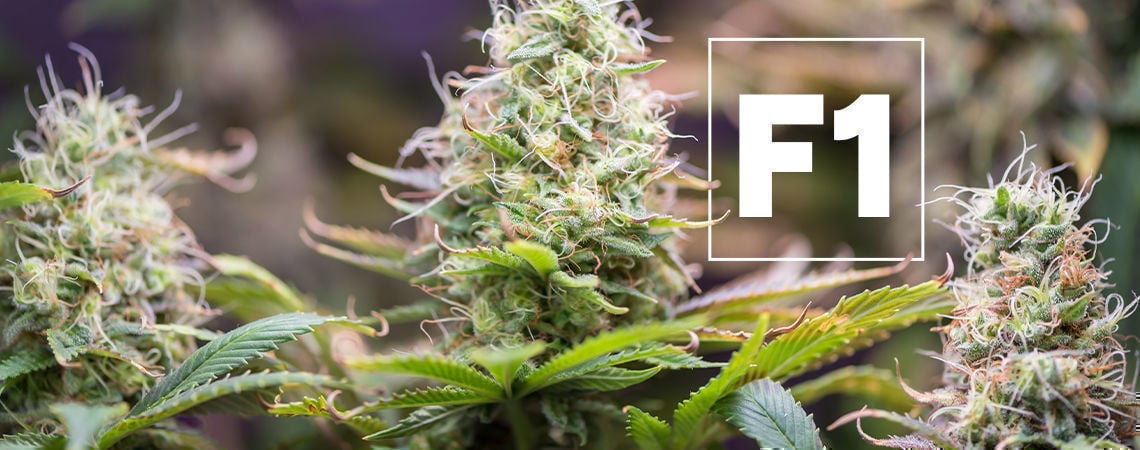
Known for its wide range of benefits, F1 hybrid technology was primarily reserved for agriculture, vegetation, and ornamental uses. But now, F1 hybrids are fast becoming commonplace in the world of cannabis. With the release of Zamnesia's own line of F1 hybrids primed for growers and consumers of all levels, it's high time (pun intended) that we give you a breakdown of everything you need to know. The difference is clear: the future of cannabis is here.
What are F1 cannabis hybrids?
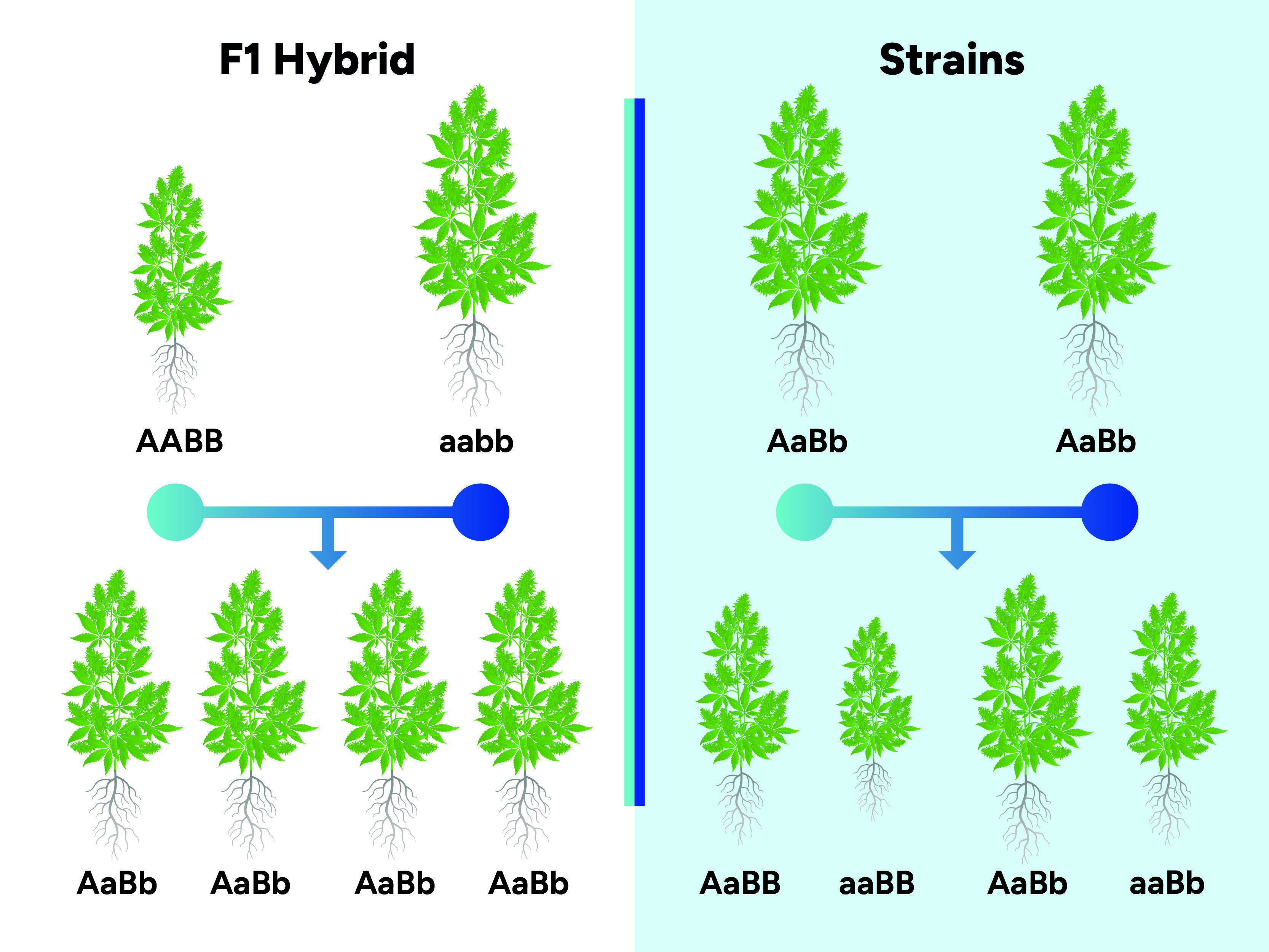
First things first, what are F1 cannabis hybrids? Otherwise known as filial 1, hybrid cannabis seeds are created by crossing two different inbred parent lines resulting from generations of inbreeding. Now, this might sound a little dodgy, but it's cannabis genetics 101. Breeders utilise groundbreaking techniques to extract alleles and use processes such as homozygosity to bring out the best qualities and streamline them in F1 hybrids. This results in a variety that's more uniform, stable, and higher-yielding compared to traditional cannabis strains, which tend to produce multiple phenotypes. But don't worry, we'll get into all of the science behind F1 hybrids soon enough.
Advantages of F1 cannabis hybrids
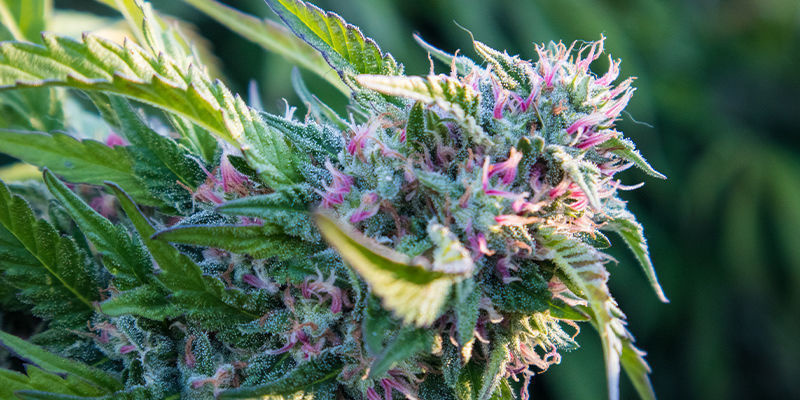
While we've already alluded to some potential benefits of using F1 hybrids, the advantages can be summed up in three words: stability, uniformity, and productivity. One by one, we'll look at each benefit offered by F1 varieties, so you know exactly what you're in for once you bust out those seeds.
✅ Stable
As mentioned, the inbred nature of F1 hybrids allows any impurities to be weeded out, resulting in a stable, robust, and resilient variety. This means that regardless of your environment, all the seeds you sow will grow into strong, hardy plants. Of course, like with all cannabis plants, care and upkeep are required when growing F1s, but their vigour and stability are unmatched.
✅ Focused on specific traits
Not only do F1 hybrids offer stability, but each variety is primed to exhibit specific traits, such as exceptional terpene and cannabinoid concentrations. This means each plant develops high levels of THC (or CBD) and exhibits diverse, intense aromas and flavours.
✅ Higher yields
A stable and reliable plant undoubtedly comes with higher yields. F1 hybrids offer up a drastic increase in bud for growers. Not only are harvests sizeable, but each plant has the potential to showcase similar yields and final heights.
✅ Faster growth
Another advantage of a stable and reliable F1 hybrid is that it has the potential to grow much faster than traditional seeds. Some varieties will reach their harvest point in just 60 days from germination, meaning growers will get their hands on the good stuff much quicker.
✅ Better than clones
Clones offer a great way to replicate traits from a mother plant, but they come with a variety of potential downfalls, including failure to root. With F1 hybrids, you get all the benefits of uniform plants but don’t need to keep a mother plant around to maintain consistent genetics.
❌ Disadvantages of F1 cannabis hybrids
While there's plenty to love about F1 hybrids, they're not without their shortcomings.
F1 hybrids have an increased level of genetic instability, meaning they are more often unable to produce seeds. In the case that they do produce seeds, the offspring will not be of the highest quality. This offspring would exhibit a vast mixture of characteristics derived from the F1 hybrid's parents and may be far less reliable. However, this factor is primarily relevant to those looking to create new strains, and is unlikely to impact the casual home-growing enthusiast.
Another possible caveat of F1 hybrids is their cost. It's no secret that these seeds do hit the wallet a little harder compared to traditional strains. Still, many would argue that the price of admission is well worth it for plants that offer the certainty of producing high-quality results.
Production process
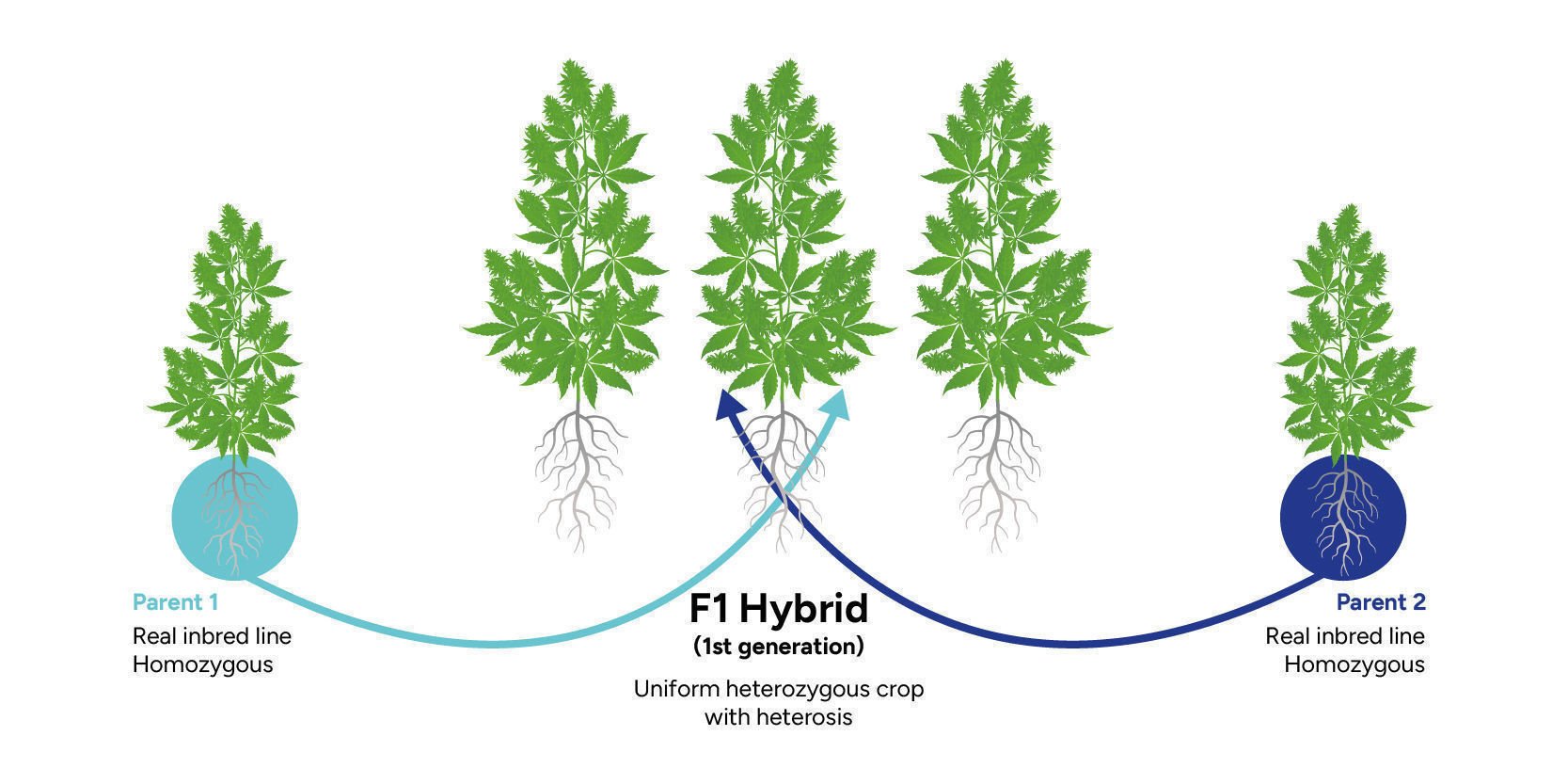
So, just how are F1 cannabis hybrids produced? We've already spoken a little about the inbred parent lines forged to create F1 hybrids. Is it just left to chance after that? Not exactly. Many aspects are involved in creating an F1 hybrid, and below we'll give you an overview of what goes on.
➡️ Alleles
Much like animals and humans, the chromosomes of cannabis plants contain alleles. These variations of genes are responsible for picking up traits to pass on. In humans, for example, this could be eye colour, but for cannabis plants, this could be attributes such as stature, yield, and appearance.
➡️ Zygosity, heterozygosity, and homozygosity
Zygosity, heterozygosity, and homozygosity are terms you’ll often see when reading about F1 cannabis seeds. These terms refer to several different processes of how alleles are separated and selected. For reference, zygosity essentially means the degree of similarity between alleles of a specific gene.
Heterozygosity refers to an organism that inherits two different alleles of a gene, taking one from each parent. In contrast, homozygosity means an organism inherits two identical alleles of a gene—one allele from each parent. Regarding F1 hybrids, both heterozygosity and homozygosity play a significant role in their formation, starting with creating an inbred line.
➡️ Creating an inbred line
Otherwise known as an IBL, an inbred line is the genetic building block of an F1 hybrid. To create an inbred line for F1 hybrid production, you start with a stable strain that has desirable traits you want to lock in. This strain is then self-pollinated over several generations to create an inbred line.
Each generation will make the line more homozygous as identical alleles are passed on. After 6–8 generations of inbreeding, the line will “breed true", meaning that the plants are homozygous for most genes, and the genetics are now stable enough to be used as a parent for making F1 hybrids.
➡️ Creating the F1 hybrid
Now that the inbred lines have been finely tuned over several generations, the work of creating an F1 hybrid can truly begin. The existing IBL is crossed with another stable inbred line with complementary traits. This cross between two homozygous parents produces F1 hybrids that are highly heterozygous and exhibit hybrid vigour—resulting in plants that exhibit exceptionally uniform growth and combine the beneficial traits of the two parent IBLs used in the original cross. In cannabis, hybrid vigour culminates in plants that often grow faster, yield higher, and have more resilience and overall vigour compared to the parent plants.
F1 hybrids vs traditional seeds
At this point, you might be wondering, exactly how do F1 hybrids differ from traditional strains? We've put together a handy table that gives you a direct comparison between the two. From phenotypes to hybrid vigour, here are some key differences and similarities between these two types of seeds.
| Traditional Cannabis Seeds | F1 Hybrid Cannabis Seeds | |
| Genetics | Heterogeneous mix of genetics | Hybrid cross of two homozygous inbred parent lines |
| Phenotypes | Multiple phenotypes | Very uniform phenotypes |
| Stability | Can be unstable | Very stable and resilient |
| Yields | Variable yields | Consistently high yields |
| Growth Rate | Typical growth rate | Faster growth rate |
| Seed Production | Can produce viable seeds | Seeds often nonviable or produce unstable offspring |
| Cost | Typically inexpensive | More expensive |
| Ideal for | Cannabis Growers | Biologists, geneticists, argronomists |
How F1 hybrids differ from other hybrids
When it comes to cannabis, we're spoilt for choice regarding the selection of traditional and hybrid varieties on offer. Even today, new ways to safely manipulate the genetics of cannabis are still being explored, with some great results. But how do F1 hybrids stack up against other hybrid varieties? Let's take a look.
What's the difference between F2, F3, and F4 hybrids?
Essentially, the main differences between F2, F3, and F4 cannabis seeds relate to how many generations of crossbreeding the variety has gone through. F2 seeds, for example, are offspring resulting from crossing two stable F1 hybrid plants, and exhibit more genetic variation compared to F1s. F3 seeds are the next step, and result from crossbreeding F2 seeds. Lastly, F4 seeds, as you may have guessed by now, are the offspring of crossbreeding the F3 generation. In general, the higher the “F” number, the more stable the genetics are. But don't worry about getting too bogged down in the science behind it all; check out our handy table below for all you need to know.
| F2 | F3 | F4 | |
| Process | Selfing F1 hybrids |
Selfing F2 seeds |
Selfing F3 seeds |
| Genetics | More heterogeneous than F1 | Increasingly homogeneous | Most homogeneous and stable |
| Phenotypes | More variation than F1 | Less variation than F2 | Most uniform phenotypes |
| Yields | Can be variable | More consistent yields | Very consistent yield |
| Stability | Less stable than F1 | More stable than F2 | Most stable genetics |
| Ideal for | Continuing a breeding project | Stabilising strain genetics | Maximising uniformity |
S1, S2, S3
The terms S1, S2, and S3 describe how many generations of self-pollination were carried out to create the seeds. Otherwise known as “selfing”, S1 seeds are created by self-pollinating stable hybrid cannabis plants. This results in seeds that have a mix of traits from both parents. Following this, S2 seeds come from self-pollinating the most desirable S1 plant. This fine-tunes the traits further, creating much more uniformity amongst the S2 generation. However, there is still some trait variation. S3 continues the trend by self-pollinating an S2 plant. It's thought that S3 has the most stable and uniform genetics out of the three mentioned here. However, F1 hybrids combine two unique genetic lines compared to S3's singular self-pollinating line, resulting in F1 hybrids being much more reliable overall.
| S1 | S2 | S3 | |
| Process | Selfing a hybrid |
Selfing S1 seeds |
Selfing F3 seeds |
| Genetics | Mix of parent genetics | More homogeneous | Most homogeneous |
| Phenotypes | More variation | Less variation | Most uniform |
| Yields | Can be variable | More consistent yields | Very consistent yield |
| Stability | Less stable | More stable | Most stable |
| Ideal for | Beginning to stabilise a strain | Continuing to stabilise | Maximising uniformity |
Poly-hybrids
Cannabis poly-hybrids are strains that are derived from breeding two or more parent strains, combining a complex mix of genetics. The multifaceted genetic makeup of poly-hybrids allows breeders to create plants that exhibit unique cannabinoid and terpene profiles and morphological traits. However, unlike true F1 hybrids, poly-hybrids tend to showcase a high degree of variability among individual plants.
Backcrosses or BX hybrids
Backcrossing is typically utilised to correct or enhance a specific trait within a line of plants. This is achieved by crossing offspring plants with their original parents. For example, crossing a strain that's 50% Blueberry and 50% Haze back to the Blueberry parent allows the breeder to strengthen the Blueberry traits in the offspring. Backcrossing over multiple generations helps to make traits more homogenous and stabilises the strain. Breeders will often look to create multiple BX generations, like BX1, BX2, and BX3, to stabilise the genetics further. Typically, growers will look to use backcrossing techniques as a quicker means of enhancing traits compared to developing stable inbred lines, such as F1 hybrids.
F1 terminology misused in the cannabis industry
When browsing other seed banks, dispensaries, and online stores, you may see the term “hybrid” or even “F1” often used. However, sometimes these words are used to push a product that isn't a true F1 hybrid, and most cannabis "hybrids" and strains labelled as F1 are not created from inbred parent lines. As discussed, true F1 hybrids are produced by crossing two homozygous inbred lines, resulting in a very uniform first filial generation.
However, most cannabis breeders will typically start with two existing heterogeneous strains that are genetically diverse. While they may call a first cross F1, this is not genetically the same as a true F1 hybrid. The terminology has become loosely applied in cannabis breeding and marketing. Without stabilised inbred parent lines, cannabis hybrids will not have the uniformity of traits seen in true F1 hybrids. As a result, the genetics remain heterogeneous across most “hybrid” cannabis strains.
Explore the world of F1 hybrids today

We've only begun to scratch the surface of what you can experience with F1 hybrids. These plants are primed to perform in various ways and are definitely worth exploring for yourself. So, if you're on the fence when it comes to F1 hybrids, there's simply no better time to pick some up. Take a look at Zamnesia's F1 collection—you won't be disappointed.

- France
- Germany
- International
- Italy
- Netherlands
- Spain
- United Kingdom
- United States
You might also like
-

 6 min
27 February 2024
Zamnesia Seeds Show Episode 2: The Perfect Storm (F1 Hybrids)
Discover the Perfect Storm—Episode 2 of Zamnesia's Seedshow. This carefully curated selection of seeds for February focuses on F1 hybrids, which are ideal for all levels of growers and stoners. If y ...
6 min
27 February 2024
Zamnesia Seeds Show Episode 2: The Perfect Storm (F1 Hybrids)
Discover the Perfect Storm—Episode 2 of Zamnesia's Seedshow. This carefully curated selection of seeds for February focuses on F1 hybrids, which are ideal for all levels of growers and stoners. If y ...
-
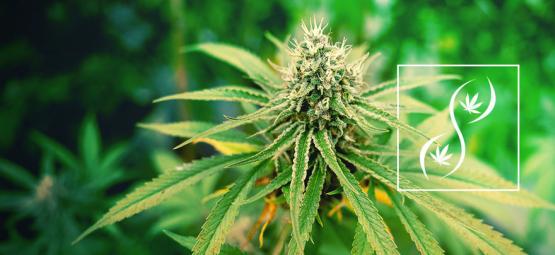
 4 min
12 December 2022
What Are F1, F2, And F3 Cannabis Seeds?
There are a lot of terms in the world of cannabis cultivation, and even more in the world of cannabis breeding. In this article, we look at terms such as F1, F2, F3, polyhybrids, and backcrossing, and ...
4 min
12 December 2022
What Are F1, F2, And F3 Cannabis Seeds?
There are a lot of terms in the world of cannabis cultivation, and even more in the world of cannabis breeding. In this article, we look at terms such as F1, F2, F3, polyhybrids, and backcrossing, and ...
Categories
-
Seed Shop
- Feminized Cannabis Seeds
- Autoflowering Cannabis Seeds
- Regular Cannabis Seeds
- F1 Hybrids
- CBD Seeds
- Zamnesia Seeds
- Top 10 Autoflowering Seeds
- Top 10 Regular Seeds
- Top 10 USA Cannabis Strains
- Top 10 Zamnesia Seeds
- Top 10 Feminized Seeds
- Beginner Strains
- Below 1% THC
- Classic Cannabis Strains
- Cup Winners
- F1 Hybrids
- Fast-Flowering Strains
- High CBD Strains
- High THC Strains
- Mix Packs
- Zamnesia Exclusive Collabs
- Amnesia Seeds
- Blueberry Seeds
- Cheese Seeds
- Diesel Seeds
- Gorilla Seeds
- Haze Seeds
- Kush Seeds
- Purple Seeds
- Skunk Seeds
- White Widow Seeds
- Zamnesia Seeds
- ACE Seeds
- Advanced Seeds
- Amsterdam Genetics
- Anesia Seeds
- Auto Seeds
- Barney's Farm
- Big Buddha Seeds
- Bomb Seeds
- BSB Genetics
- BSF Seeds
- Buddha Seeds
- Bulldog Seeds
- Cali Connection
- Cannarado Genetics
- CannaBioGen
- CBD Crew
- CBD Seeds
- Compound Genetics
- The Dank Seeds
- Dark Horse Genetics
- Delicious Seeds
- Devil Harvest Original
- Dinafem
- DNA Genetics
- Doctor's Choice
- Dr. Underground
- Dutch Passion
- Elite Seeds
- Eva Seeds
- Exotic Seed
- Expert Seeds
- FastBuds
- Female Seeds
- Fenocan
- Flash Auto Seeds
- French Touch Seeds
- Garden of Green
- GeneSeeds
- Genehtik Seeds
- G13 Labs
- Grass-O-Matic
- Greenhouse Seeds
- Grow Your Own (DNA)
- Growers Choice
- Homegrown Fantaseeds
- House of the Great Gardener
- Humboldt Seed Company
- Humboldt Seed Organization
- Kalashnikov Seeds
- Kannabia
- The Kush Brothers
- Light Buds
- Little Chief Collabs
- Medical Seeds
- Ministry of Cannabis
- Mr. Nice
- Nirvana Seeds
- Original Sensible
- Paradise Seeds
- Perfect Tree
- Pheno Finder
- Philosopher Seeds
- Positronics Seeds
- Purple City Genetics
- Pyramid Seeds
- Rare Dankness
- Reggae Seeds
- Reserva Privada
- Resin Seeds
- Ripper Seeds
- Royal Queen Seeds
- Sagarmatha Seeds
- Samsara Seeds
- Seedstockers
- Sensation Seeds
- Sensi Seeds
- Serious Seeds
- Silent Seeds
- Soma Seeds
- Spliff Seeds
- Strain Hunters
- Sumo Seeds
- Super Sativa Seed Club
- Super Strains
- Sweet Seeds
- T.H. Seeds
- Top Tao Seeds
- Vision Seeds
- VIP Seeds
- White Label
- World Of Seeds
- Zativo Seeds
- Seed Banks
-
Headshop
-
Vaporshop
-
Healthshop
-
Smartshop
- Top 10 Smartshop
- Zamnesia Gift Cards
- After Party
- Aphrodisiacs
- Aromatherapy
- Blue Lotus
- CBD Vape Juice
- Capsule Machines
- Crystals, Gemstones & Minerals
- Dream Herbs
- Drug Tests
- Extracts
- Happy Caps
- Herbal Tea
- Herbs & Seeds
- Incense
- Kanna
- Kratom
- LSA Seeds
- Mescaline Cacti
- Microdosing
- Nootropics
- Relaxing
- Salvia divinorum
- Smart Seeds
- Stimulants
- Supplements
- Tinctures
- Vape Herbs
-
Shroomshop
-
Growshop
- Top 10 Growshop
- Top 10 Plant Seeds
- All Seeds
- Cacti
- Chilli & Pepper Seeds
- Companion Plants
- Edible Plant Seeds
- Exotic Seeds
- Flower Seeds
- Fruit Seeds
- Herb Seeds
- Interior Plant Seeds
- Microgreens
- Psychoactive Plant Seeds
- Sprouting
- Vegetable Seeds
- Wellness Plant Seeds
- After Harvest
- Climate Control
- Fertilizer
- Grow Tents
- Harvest, Dry & Cure
- LED Grow Lights
- Plant Seeds
- Propagation
-
Merchandise
-
Sale section
Account
Information
Our Offers
Our website won't work without these cookies activated. Therefore functional cookies can't be disabled.























